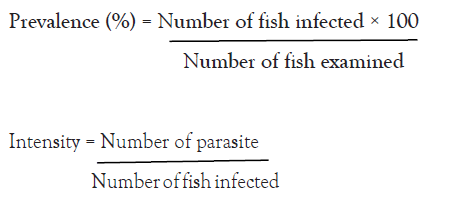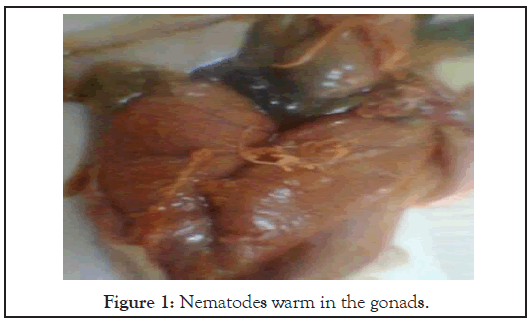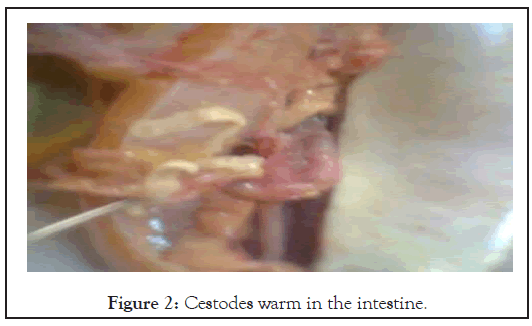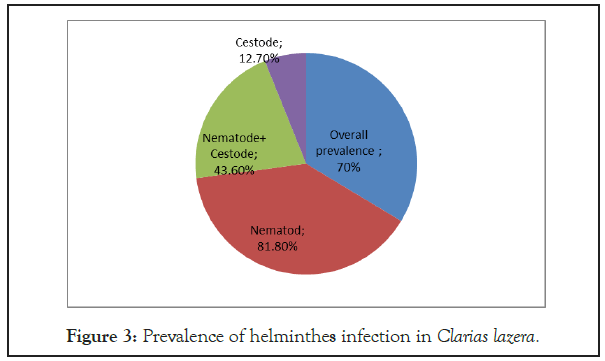Poultry, Fisheries & Wildlife Sciences
Open Access
ISSN: 2375-446X
ISSN: 2375-446X
Research Article - (2021)Volume 9, Issue 6
The present study was designed to decide the rate of helminths parasites in Clarias lazera fishes in Jebel Aulia dam in relation to length, weight and condition factor index. A total of three hundred (300) fish sampled were secured from fishermen at the landing site for parasitic examination. They were inspected for parasitic infections utilizing direct wet mount microscopy and recolored smears. Standard length and fish body weights and condition index were determined. The results showed that, a total number 210(70%) of 300 examined Clarias lazera were infected. The fishes sampled were infected with nematode represented by (81.8%), and Cestode (12.7%), while the co-infected (Nematode and Cestode) (43.6%). Fishes in length 52-66 cm and 40-62 cm recorded highly correlation to helminths prevalence and medium in the length group 32-69 cm. The weight of the fish samples recovered by nematode ranged from 38 to 1020 g, Cestode from 600 to 2200 g while Co-infected ranged from 950 to 1500 g. The infection leads to a decrease in the condition factor of fish infected with nematodes and the co-infection only while the effect of Cestode to fish cannot be illustrated by the condition factors. This study clarifies that larger size C. lazera provide a larger surface region for parasitic infection than the smaller ones. The study moreover appeared that there was a significant (P<0.05) correlation between infection rate of C. lazera body size, and weight.
Parasitic infection; Weight; Length; Clarias lazera; Jebel Aulia reservoir
Fish and seafood constitute an important food component for an expansive segment of the world populace [1]. Fish and fish products are the foremost vital source of protein and other fundamental components that are essential for the support of healthy body to the human particularly within the creating nations [2]. Clarias species occupy calm freshwaters extending from lakes, streams, rivers, swamps to flood plains, numerous of which are subject to seasonal drying. The most common environments of catfish are flood plains, swamps and pools. The catfish can survive amid the dry seasons due to the ownership of extra discuss breathing organ [3,4].
Parasitic diseases decrease fish production by influencing the typical physiology of fish and can result in mass mortalities of fish in the case that remained unmonitored [5]. Parasites in fish have been a great concern since they regularly create illness condition in fishes this manner expanding their helplessness to other illnesses, causing nutritive depreciation of fish and fish loss [6]. Helminths parasites regularly happen inside the viscera and body depression of catfish particularly the digestive tract, subsequently; they more often than not harm the gastrointestinal tract [7]. Determination of the rate of parasitic infections in fish especially gastrointestinal helminths infection plays a vital part in the study of fish parasitic diseases and in particular their routes of transmission to other hosts. Food-borne parasitic infections have recently been identified as an important public health problem with considerable economic effects in terms of morbidity, loss of productivity, and healthcare costs [8]. Infection in fish is also an indirect risk to human morphology and physiology. So it is essential that fish body must be kept up free of infections and all necessary estimation ought to be taken for doing so.
The Length-weight relationship and condition factor are useful biological tools that have been applied to look at the effect of environmental changes on the well-being of fish [9]. length-weight and length-length relationships, condition factor and growth are important tools for fish species [10]. Agreeing to Esiest parasitic worms can cause swollen abdomen in fishes thereby contributing to either pseudo weight or length of fishes and can moreover lead to stunted growth in this manner decreasing the length and weight of the fish [11]. In any case, there is a shortage of data on the characteristic relationship between length weight and condition factor and how parasitic infections influence the relationships in wild fishes in Sudan. Subsequently, the present research was carried out to uncover the conceivable impact of helminth parasitic loads on length, weight and condition factor of Clarias lazera.
Sample Collection and Identification
More than three hundred lively catfish specimens were randomly acquired from the local fishermen in the region of Jebel Aulia Dam, one of the most fish locations in the northern part of the White Nile, 45 km. South of Khartoum. Samples were transported live in clean plastic bags containing water and to the laboratory, faculty of the agriculture and fish sciences. They were identified based on external features as described by [12,13]. Standard Length (SL) of the fish samples was taken along the body axis using a measuring board to the closest centimeter (cm) and recorded. Fish samples were also weighed to the nearest gram (g) employing a manual weighing balance and recorded.
Dissection and examination for parasite
Due to the parasitic screening, two common parasites were chosen to be examined in this study namely the Nematode and the Cestode. The reason for their choice to be the target parasites for this study was their heavy infection to the C. lasers as well as other fishes collected from the Jebel Aulia site which recorded a high prevalence of up to 100%.
A cut was made on the ventral side of the fish from the anal opening to the lower jaw using dissecting scissors to expose the body cavity and most of the internal organs. The stomach and intestine were isolated and kept in several test plates containing 0.9% saline solution. Each section was opened longitudinally and inspected for parasites under a dissecting microscope. Parasites found were counted, settled, and protected in 10% formalin [14]. Parasites were identified using the technique described by [15,16]. The prevalence and intensity were calculated using the formulae below

Statistical analysis
Statistical package for social science SPSSInc, software (version 20.0) was utilized to perform one-way analysis of variance (ANOVA) and regression analysis. All the statistical analyses were considered at a significance level set at p<0.05.
Three hundred fish samples were subjected to parasitological examination. Parasites recovered were Nematodes and Cestodes. Nematodes were of diverse sizes found coiled inside the intestines and within the gonad sheath. The collected samples were classified according to Figure 1 [17]. The Cestode was found in both larval and mature stages at the rate of 1-4 parasites per fish. These were found inside the lumen of small intestines and the pyloric ceca. Descriptions of Cestode according to Figure 2 [18].

Figure 1: Nematodes warm in the gonads.

Figure 2: Cestodes warm in the intestine.
Prevalence of parasites
In general, 210(70%) of 300 examined Clarias lazera were infected with Nematodes and Cestode (43.6%). The fishes sampled were infected with Nematode (81.8%), and Cestode (12.7%) (Figure 3). The intensity of helminth infection by the nematode was heavy with more than 30 warms/fish with an average of 13.38 ± 0.95, the intensity of infection with the Cestode was 4.0 ± 0.5 for high intensity. A few of C. lazera recorded concurrent infection with the both parasites as co-infection with intensity of infection 6.15 ± 0.2 (Table 1).

Figure 3: Prevalence of helminthes infection in Clarias lazera.
The effects of parasitic infection on the growth of C. lazera
The growth assessment of the healthy and infected C. lazera was based on assessing standard length, body weight, and condition coefficient index that correlate the weights of fishes to the corresponding lengths. The variety in size of the catfishes in relation to helminthic infection of Clarias lazera is presented in Table 1. Fishes in length 52-66 cm and 40-62 cm recorded highly correlation to helminths prevalence and medium in the length group 32-69 cm. The weight of the fish samples recovered by nematode ranged from 38 to 1020 g, Cestode from 600 to 2200 g while Co-infected ranged from 950 to 1500 g. The results also showed a high correlation between fish sample infections and their weight (Table 1). Also, the condition factor (K) of the sampled fishes was significantly influenced by helminthic infection (p<0.05). However, co-infection influenced Fulton’s condition index (K) of the fishes sampled a strong negative correlation (r=-1.00).
| Parasitic infection | Mean intensity infection ± SD (worm/fish) | Standard length(cm) mean ± SD (min-max) |
R to SL | Weight (g) Mean ± SD (Min-Max) |
R to W | Condition factor (g/cm3) K Mean ± S.D (Minâ??Max) |
R to K |
|---|---|---|---|---|---|---|---|
| Non infected | 0.00                  | 39.7 ± 0.68 (35-48) |
1.00 | 673.57 ± 0.54 (350-2300) |
1.0 | 1.08 ± 0.58 (0.96-1.20) |
1.00 |
| Nematode infection | 13.38 ± 0.95 | 45.82 ± 0.61 (32-69)  |
0.68 | 547.55 ± 2.67 (38-1020) |
0.80 | 0.63 ± 0.57 (0.58-0.68) |
-1.00 |
| Cestode infection | 4.0 ± 0.5 | 54 ± 1.17 (40-62) |
0.99 | 1600 ± 1.78 (600-2200) |
0.99 | 0.93 ± 0.52 (0.85-1.01) |
-0.43 |
| Co-infected | 6.15 ± 0.2 | 57.33 ± 0.7 (52-66) | 0.99 | 1600 ± 1.78 (950-1500) |
0.78 | 0.80 ± 0.28 (0.73-.87 |
-1.00 |
Table 1: Intensities of helminthic parasites recovered from C. lazera and comparison to length, weight condition factor (K) (g/cm3).
In spite of increasing requested for fishes, most people do not focus so much attention on fish health situations like other livestock animals. Fish is additionally inclined to diseases like parasitism [19]. Parasitic helminths in natural habitats can drastically decrease their wellness, and in like a manner has have advanced capable counter-measures to control infection [20]. The difference in the prevalence of parasites in fish may be due to many factors, which are determined by the interaction between biotic and abiotic factors.
In this study, an overall prevalence rate of parasitic infestation 210 (70%) was recorded within the body of Clarias lazera fish caught was higher. The highest infestation rate in C. lazera, may well be ascribed to its feeding behavior as a carnivorous fish, (bottom feeder) and the availability of intermediate hosts (copepods, insects, molluscs, etc.) which harbor the infective larval stage of some of these parasites. In addition, such fish are scale less; this may permit the penetration of the infective stages into the external body surface making. The high prevalence of fish parasites recorded in the research agrees with the work with Kawe et al. who recorded high prevalence (67.5%) of gastrointestinal helminth parasites of C. gariepinusin in Nigeria and to the findings of [21], the total infestation rate was in C. gariepinus (75.71%) from fish farms in Ismailia province [16]. The Nematodes were recovered from both the stomach and intestine. This due to relatively developed alimentary canal and could easily to feed on digested and semi-digested food [16]. Higher prevalence for Nematodes (81.80%) was observed. During their life cycle, Nematodes live generally in two intermediate hosts, a micro- crustacean copepod and a vertebrate. The highest mean abundance and intensity for nematodes be explained by the endogenous multiplication of this parasite [22]. Cestode showed preference for the intestine, it lack alimentary system and are dependent on digested food of the host which is then absorbed through the body surfaces [23]. The Cestodes have low prevalence rate (12.70%) in the intestine, it is due to incomplete life cycle of these Cestodes and further transmission comes to an end.
In this study, a significant positive relationship between standard length and parasite abundance was observed for the species Clarias lazera. Prevalence of parasites C. lazera based on standard length with range 32-69 cm and 52-66 cm gave the highest prevalence. Prevalence of parasites based on weight showed that weight of the C. lazera range 38-1020 g and 600-2200 g gave high prevalence. In this way recommending that bigger fish may ingest a bigger amount of food. This perception may be attributed to the fact that larger size C. lazera provides a larger surface zone for parasitic infection than the smaller ones. These results agree with Olajide JA noted that catfishes with bodyweight 500-599 g had the most elevated predominance (100%) both in cultured and natural habitats [2].
In fisheries science, the condition factor is utilized in arrange to compare the “condition”, “fatness” or prosperity of fish. It is based on the speculation that heavier fish of specific length is in a better physiological condition [24]. The mean condition factor of infected sampled fishes in the present study was lower than one (>1), suggesting not great fish wellbeing. Generally, the mean value of the condition factor gotten for the uninfected fishes was altogether higher than that of infected fishes. The condition factor of non-infected was 1.00 i.e. within the normal range. For those of infection by nematode, the condition factor was 0.63 ± 0.57, not at all like in Cestode where the condition factor was as high as 0.93 ± 0.52. Within co-infection, the condition factor was 0.80± 0.28. This demonstrates that the infection leads to a decrease in the condition factor of fish infected with nematodes and the co- infection as it were whereas the impact of Cestodes on fish cannot be illustrated by the condition factors only. In the present study, the condition index was significantly different between the parasitized and non-parasitized fishes. These come about are reliable with past studies which have detailed that the pathogenicity of parasites was connected to a few variables factors concurring to species, sex and season, and parasite status of the fish.
In conclusion, the present study shows the prevalence of gastrointestinal helminthes with heavy parasitic in C. lazera inspected in Jebel Aulia Dam. Furthermore, the results from this study reported here strongly infection Influence the length, weight and condition factor of fishes.
Further considers are required to set up the different components that impact the predominance of gastrointestinal helminths, considering the ensuing pathogenicity and the aquaculture esteem of C. lazera in Sudan.
Citation: Mahmoud ED, Ahmed EO, Rahman AAE, Abdallah SY (2021) Incidence of the Helminth Infection in Relation to the Weight and Length of Clarias lazera in Jebel Aulia Dam. Poult Fish Wildl Sci. 9:217.
Received: 15-Apr-2021 Accepted: 29-Apr-2021 Published: 06-May-2021 , DOI: 10.35248/2375-446X.21.9.217
Copyright: © 2021 Mahmoud ED, et al. This is an open-access article distributed under the terms of the Creative Commons Attribution License, which permits unrestricted use, distribution, and reproduction in any medium, provided the original author and source are credited.